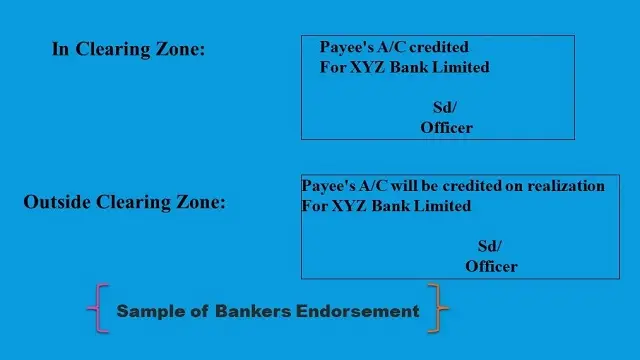In a simple sense, we usually practice “endorsement” is to sign on the back part of the cheque before we deposit it or cash it to a Bank.
Here, in this guide, we provide you with a detailed explanation of “What is Endorsement of a Cheque? A Complete Guide for How to Endorse a Cheque.”
Definition of Endorsement:
When you are paid with a cheque, you will normally sign it on the back so that you can deposit it in your bank account or cash it. Signing a cheque in this way is known as endorsing a Cheque.
Section 15 of N.I. Act, 1881: “when the maker or holder of a negotiable instrument signs his name, otherwise than such maker, for the purpose of negotiation, on the back or face thereof or on a slip of paper annexed thereto he is said to have endorsed the instrument.
To endorse a Cheque two parties are involved here, one ‘endorser’ and the other ‘endorsee’.
The person who indorses is called ‘endorser’ and the person in favour of whom the endorsement is made is called ‘endorsee’.
Read Also: How to write a Bank Cheque?
How to Endorse a Cheque
Mostly we endorse a cheque by signing the back of it. On most cheques, there is a box at the back side of a cheque containing at least three lines that have the heading “Endorse Here,” and another, larger box below it with the heading “Do Not Write, Stamp, or Sign Below This Line.” You should endorse the cheque in the top box.
How you choose to endorse a cheque depends on what you want to do with the amount associated with the cheque. The reason why banks require you to endorse cheques is to prevent cheque-based fraud and improve your banking security. Signing the back of a cheque helps to confirm your identity.
In our country, we rarely practice proper endorsement when paying a check. Blank endorsements are most often practiced. Banks usually require two signatures of the payee when paying cash over the counter.
Types of Cheque endorsements
There are four main types of endorsements you can use:
- Restrictive Endorsement
- Blank Endorsement,
- Endorsing A Third-Party Cheque
- Banker Endorsement
01. Restrictive Endorsement
Restrictive endorsements are the most secure method of endorsement of a cheque. To make one, you should, in any order:
- Write “For Deposit Only” on one line
- Write the account number on another line
- Sign your name on another line
This method specifically instructs the bank that the cheque should be deposited into the account identified in the endorsement.
02. Blank Endorsement for a Cheque
This is the least secure way to endorse a cheque, commonly use in our country as a form of endorsement. A blank endorsement is the most common way to endorse a cheque. A cheque holder (or payee) who wishes to make a blank endorsement can just sign the endorsement area of the cheque, indicating that they accept transfer of the funds.
03. Endorsing a Third-Party Cheque
If you receive a check and want to give that check to a third party for a payment you owe them, then you can do this with an endorsement.
- Write: Pay to the order of [Person’s Name]
- Then sign the cheque
04. Banker’s Endorsement
To collect on behalf of the customer, a collecting banker endorses an instrument as a certification that the paying banker will pay the amount for crediting the customer’s account. The form of the Banker’s endorsement is as shown in the picture;

COMMON RULES REGARDING ENDORSING OF A CHEQUE
- A regular endorsement implies the signature of the holder of the negotiable instrument himself or his duly authorized agent on its face or back for the purpose of negotiation.
- The payee must sign his name in the exact spelling as appears on the instrument.
- Endorsements in pencil or by a rubber stamp are usually not accepted.
- Endorsements need not contain complimentary prefixes or suffixes.
- Endorsements do not require any particular form of words. However, it must contain an order to pay.
- An illiterate person can make a valid endorsement by putting his left-hand thumb impression in the presence of certain other persons who should sign it as witnesses and whose addresses should also be given.
- In the case of joint stock companies, associations etc., the endorsement should be made by persons who are duly authorized to sign on behalf of these institutions.
- Endorsement by a stranger to a negotiable instrument, i.e., by a person other than the holder, maker or the person to whose order the bill is payable, shall not be valid. Such a person is known as a ‘Backer’.
- Endorsement shall be presumed to have been made in the order in which they appear on the instrument proved to the contrary.
- An express promise in writing to endorse a bill is not an endorsement. Assignment of a note by a separate writing is also not an endorsement.
- An endorsement must be completed by the delivery of the instrument.
LIABILITY OF ENDORSER
- In absence of a contract to the contrary, the endorser of a negotiable instrument engages that on due presentment it shall be accepted and paid according to its tenor, and
- That if it is dishonored, he will compensate to the holder or subsequent endorser who is compelled to pay it for any loss or damage caused to him by such dishonor.
RIGHT OF ENDORSEE
- The endorsee has the right to receive or recover the money mentioned in the instrument.
- If the endorsee becomes a holder in due course, he can make liable every prior party to a negotiable instrument until the instrument is duly satisfied.
You might also like these posts:
01. What are the reason for Cheque Dishonour?
02. Is the Account payee cheque really safe? Best way to write account payee cheque in 2022.


